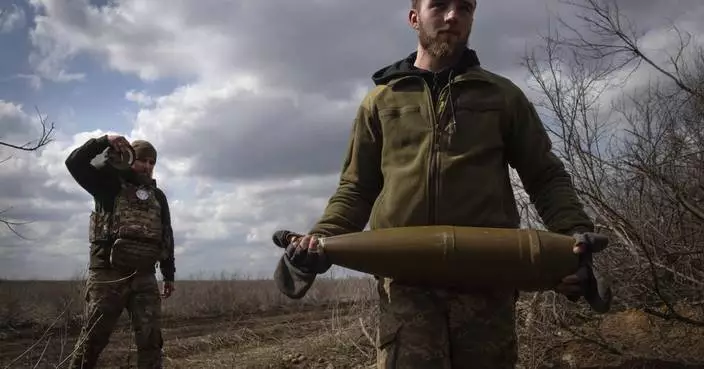Pennsylvania's treasury department is accusing about a dozen large financial firms of working together to illegally inflate the price of bonds issued by Fannie Mae and Freddie Mac over seven years.
A federal court filing by Pennsylvania Treasurer Joe Torsella cites what his office says is evidence from a "cooperating co-conspirator" in a U.S. Department of Justice investigation into price-fixing in the secondary market for bonds issued by government-controlled companies.
Evidence cited in the filing late Thursday includes brief transcripts of what it says are electronic chats between traders from various financial institutions that are the largest dealers of the bonds.
In the discussions, the traders allegedly agree to fix bond prices at artificially inflated prices, cheating Pennsylvania and other buyers of the bonds. The price-fixing began in 2009 and lasted through 2015, and violates federal anti-trust law, Torsella's filing said.
In one 2012 exchange in Torsella's filing, a Morgan Stanley trader says, "I just don't want to create a race to the bottom between the 3 of us, doesn't help anyone."
That trader and traders from Deutsche Bank and BNP Paribas then agree on a price.
One trader proposes a price of $99.985, another agrees and the third responds, "Good by me."
An analysis shows that pricing patterns are consistent with such a price-fixing agreement, the filing said. The "economic fingerprints" of the conspiracy diminished after January 2016, when the cooperating co-conspirator discovered it, it said.
Torsella's office said it is bound by a confidentiality agreement and could not reveal how it came to receive information from the cooperating co-conspirator. It would not say who the confidentiality agreement is with.
Named as defendants are Barclays, Bank of America, Citigroup, Credit Suisse, Goldman Sachs, BNP Paribas, First Tennessee Bank, TD Securities, Morgan Stanley, Nomura, JP Morgan, Cantor Fitzgerald, UBS and HSBC.
Most firms declined to comment, while other financial institutions contacted by The Associated Press did not immediately respond Friday. Some asked for a copy of the lawsuit.
Justice Department spokesman Jeremy Edwards declined comment Friday.
The bonds are a cornerstone for the investment portfolios of government and institutional investors, and Torsella's office said it expects that a large number of governments, public agencies, pension funds and other public institutional investors are victims of the alleged conspiracy.
Thursday's filing is part of an ongoing case in federal court in New York's southern district being led by Torsella's office.
Pennsylvania is seeking class action in the case, which has consolidated lawsuits by various government entities, labor unions and public pension systems, including the city of Baltimore.
It said Pennsylvania's various state agencies bought or sold $63 billion in so-called GSE bonds during the seven-year period. Torsella's office is in the process of determining how much money state agencies lost because of the alleged price-fixing scheme, officials there said.
The Department of Justice hasn't filed any criminal charges and the cooperating co-conspirator is not directly identified in Torsella's court filing.
However, Torsella's filing identifies Deutsche Bank as a co-conspirator and one of various entities that participated in the violations, but that are not named as defendants. A Deutsche Bank spokesman declined comment Friday.
In a March filing in the case, the Alaska Electrical Pension Fund lobbed similar accusations against a nearly identical group of financial firms, saying traders communicated through electronic chatrooms, instant messaging, emails, telephone and in-person meetings.
It went on to name 27 "key personnel" on the desks that traded the bonds in question at 11 firms: Bank of America, Barclays, BNP Paribas, Citigroup, Credit Suisse, Deutsche Bank, FTN Securities, Goldman Sachs, JP Morgan, Morgan Stanley and UBS.
They shared "highly sensitive trading information about their own books and about the trading strategies of their customers," positioning themselves to earn "extraordinary trading profits in the secondary market," it said.
Buyers didn't know that the firms' traders had secretly agreed not to compete, and often sought to drive competition among the firms to get a better price, the Alaska Electrical Pension Fund's lawsuit said.
"Little did they know that, behind the scenes, defendants would invariably share their clients' confidential information and coordinate their actions to ensure such efforts to benefit from competition went nowhere," it said.
Associated Press reporter Michael Balsamo in Washington, D.C., contributed to this report.
KYIV, Ukraine (AP) — A big, new package of U.S. military aid will help Ukraine avoid defeat in its war with Russia. Winning will still be a long slog.
The arms and ammunition in the $61 billion military aid package should enable Ukraine to slow the Russian army's bloody advances and block its strikes on troops and civilians. And it will buy Ukraine time — for long-term planning about how to take back the fifth of the country now under Russian control.
“Ultimately it offers Ukraine the prospect of staying in the war this year,” said Michael Clarke, visiting professor in war studies at King’s College London. “Sometimes in warfare you’ve just got to stay in it. You’ve just got to avoid being rolled over.”
The U.S. House of Representatives approved the package on Saturday after months of delays by some Republicans wary of U.S. involvement overseas. It was passed by the Senate on Tuesday, and President Joe Biden said he would sign it Wednesday.
The difference could be felt within days on the front line in eastern and southern Ukraine, where Russia’s much larger army has been slowly taking territory against massively outgunned Ukrainian forces.
The aid approval means Ukraine may be able to release artillery ammunition from dwindling stocks that it has been rationing. More equipment will come soon from American stocks in Poland and Germany, and later from the U.S.
The first shipments are expected to arrive by the beginning of next week, said Davyd Arakhamia, a lawmaker with Ukrainian President Volodymyr Zelenskyy’s Servant of the People party.
But opposition lawmaker Vadym Ivchenko, a member of the Ukrainian parliament’s National Security, Defense and Intelligence Committee, said logistical challenges and bureaucracy could delay shipments to Ukraine by two to three months, and it would be even longer before they reach the front line.
While details of the shipments are classified, Ukraine’s most urgent needs are artillery shells to stop Russian troops from advancing, and anti-aircraft missiles to protect people and infrastructure from missiles, drones and bombs.
What’s coming first is not always what front-line commanders need most, said Arakhamia, the Ukrainian lawmaker. He said that even a military giant like the U.S. does not have stockpiles of everything.
“The logic behind this first package was, you (the U.S.) finds our top priorities and then you see what you have in the warehouses,” Arakhamia said. “And sometimes they do not match.”
Hope for future breakthroughs for Ukraine still hangs on more timely deliveries of Western aid, lawmakers acknowledge.
Many experts believe that both Ukraine and Russia are exhausted by two years of war and won’t be able to mount a major offensive — one capable of making big strategic gains — until next year.
Still, Russia is pushing forward at several points along the 1,000-kilometer (600-mile) front, using tanks, wave after wave of infantry troops and satellite-guided gliding bombs to pummel Ukrainian forces. Russia is also hitting power plants and pounding Ukraine’s second-largest city, Kharkiv, which is only about 30 kilometers (some 20 miles) from the Russian border.
Ivchenko said the goal for Ukraine’s forces now is to “hold the line” until the bulk of new supplies arrive by mid-summer. Then, they can focus on trying to recapture territory recently lost in the Donetsk region.
“And probably ... at the end of summer we’ll see some movement, offensive movement of the Ukrainian armed forces,” he said.
Some military experts doubt Ukraine has the resources to mount even small offensives very soon.
The U.S. funding “can probably only help stabilize the Ukrainian position for this year and begin preparations for operations in 2025,” said Matthew Savill, director of military sciences at the Royal United Services Institute, a think tank.
In the best-case scenario for Ukraine, the American aid will give commanders time to reorganize and train its army — applying lessons learned from its failed summer 2023 offensive. It may also galvanize Ukraine’s allies in Europe to increase aid.
“So this just wasn’t about Ukraine and the United States, this really affected our entire 51-country coalition,” said U.S. Congressman Bill Keating, a Democrat who visited Kyiv on Monday as part of a four-member congressional delegation.
Zelenskyy insists Ukraine's war aim is to recapture all its territory from Russia — including Crimea, seized illegally in 2014. Even if the war ultimately ends through negotiation, as many experts believe, Ukraine wants to do that from as strong a position as possible.
Whatever happens on the battlefield, Ukraine still faces variables beyond its control.
Former U.S. President Donald Trump, who seeks to retake the White House in the November election, has said he would end the war within days of taking office. And the 27-nation Europe Union includes leaders like Hungarian President Viktor Orbán and Slovakian Prime Minister Richard Fico, who have opposed arming Ukraine.
Ukraine’s allies have held back from supplying some arms out of concern about escalation or depleting their own stocks. Ukraine says that to win the war it needs longer-range missiles it could use for potentially game-changing operations such as cutting off occupied Crimea, where's Russia's Black Sea fleet is based.
It wants Army Tactical Missile Systems, known as ATACMs, from the U.S. and Taurus cruise missiles from Germany. Both governments have resisted calls to send them because they are capable of striking targets deep within Russian territory.
The new bill authorizes the president to send Ukraine ATACMS “as soon as practicable.” It's unclear what that will mean in practice.
Sometimes, promised weapons have arrived late, or not at all. Zelenskyy recently pointed out that Ukraine is still waiting for the F-16 fighter jets it was promised a year ago.
Meanwhile, Russia is using its advantage in troops and weapons to push back Ukrainian forces, perhaps seeking to make maximum gains before Ukraine's new supplies arrive.
For weeks it has pummeled the small eastern city of Chasiv Yar, at the cost of 900 soldiers killed and wounded a day, according to the U.K. Ministry of Defense.
Capturing the strategically important hill town would allow them to move toward Sloviansk and Kramatorsk, key cities Ukraine controls in the eastern region of Donetsk. It would be a significant win for Russian President Vladimir Putin, who Western officials say is bent on toppling Ukraine’s pro-Western government.
Russian pressure was aimed not just at gaining territory, but on undermining Zelenskyy and bolstering critics who say his war plan is failing, said Clarke of King's College London.
The U.S. aid package decreases the likelihood of a political crisis in Ukraine, and U.S. Speaker Mike Johnson deserves credit for pushing it through Congress, he said.
"He held history in his hands,” Clarke said.
Follow AP’s coverage of the war in Ukraine at https://apnews.com/hub/russia-ukraine
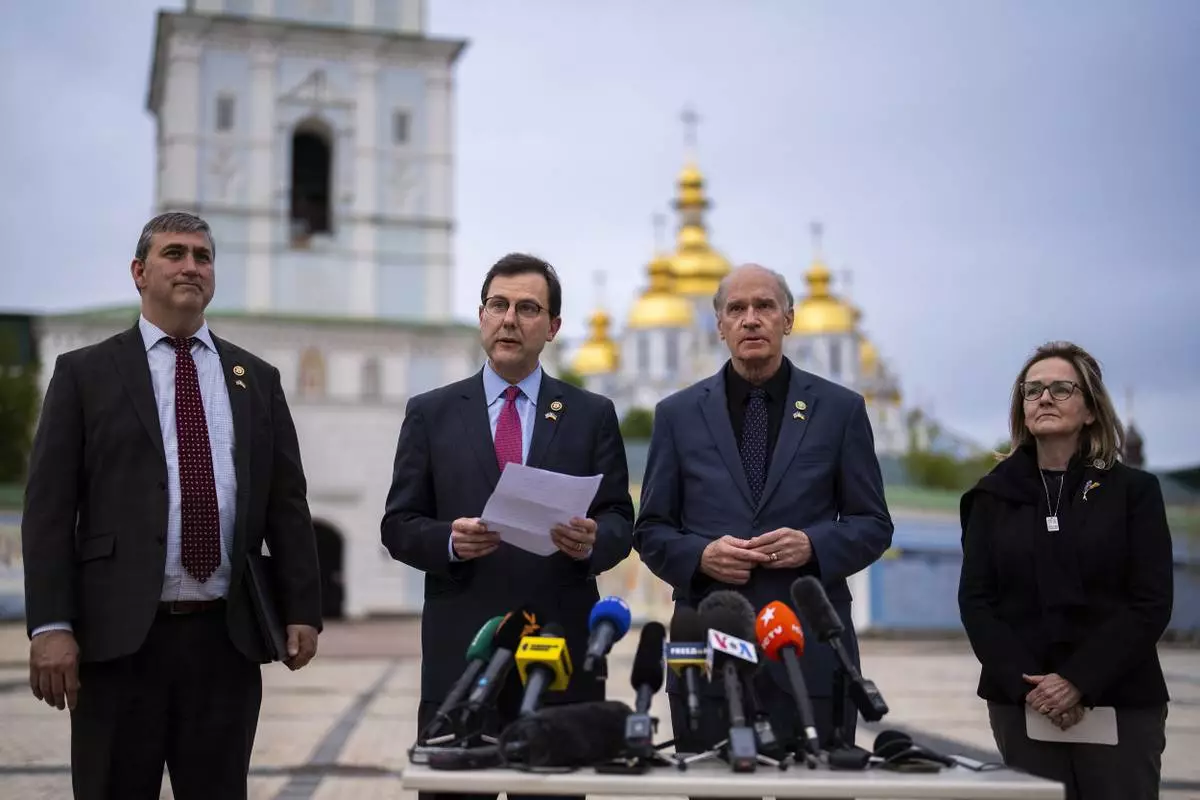
From left, U.S. representatives Nathaniel Moran, R-Tx, Tom Kean Jr, R-NJ, Bill Keating, D-Mass, and Madeleine Deane, D-Pa, talk to journalists during a joint news conference outside Saint Michael cathedral in Kyiv, Ukraine, Monday, April 22, 2024. A newly approved package of $61 billion in U.S. aid may prevent Ukraine from losing its war against Russia. But winning it will be a long slog. (AP Photo/Francisco Seco)

A volunteer makes a camouflage net at a facility producing material for Ukrainian soldiers in Kyiv, Ukraine, Monday, April 22, 2024. A newly approved package of $61 billion in U.S. aid may prevent Ukraine from losing its war against Russia. But winning it will be a long slog. (AP Photo/Francisco Seco)
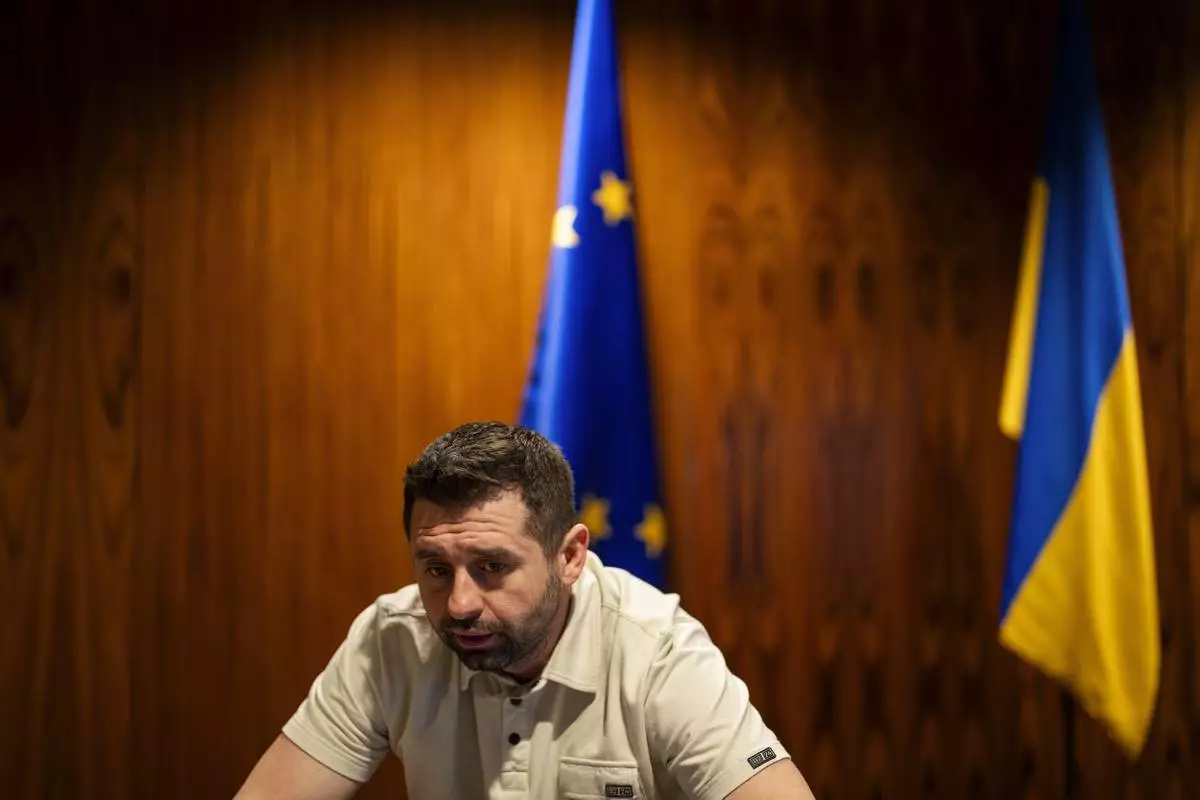
Davyd Arakhamia, a lawmaker with Ukrainian President Volodymyr Zelenskyy's Servant of the People party, talks during an interview with Associated Press in Kyiv, Ukraine, Monday, April 22, 2024. (AP Photo/Francisco Seco)
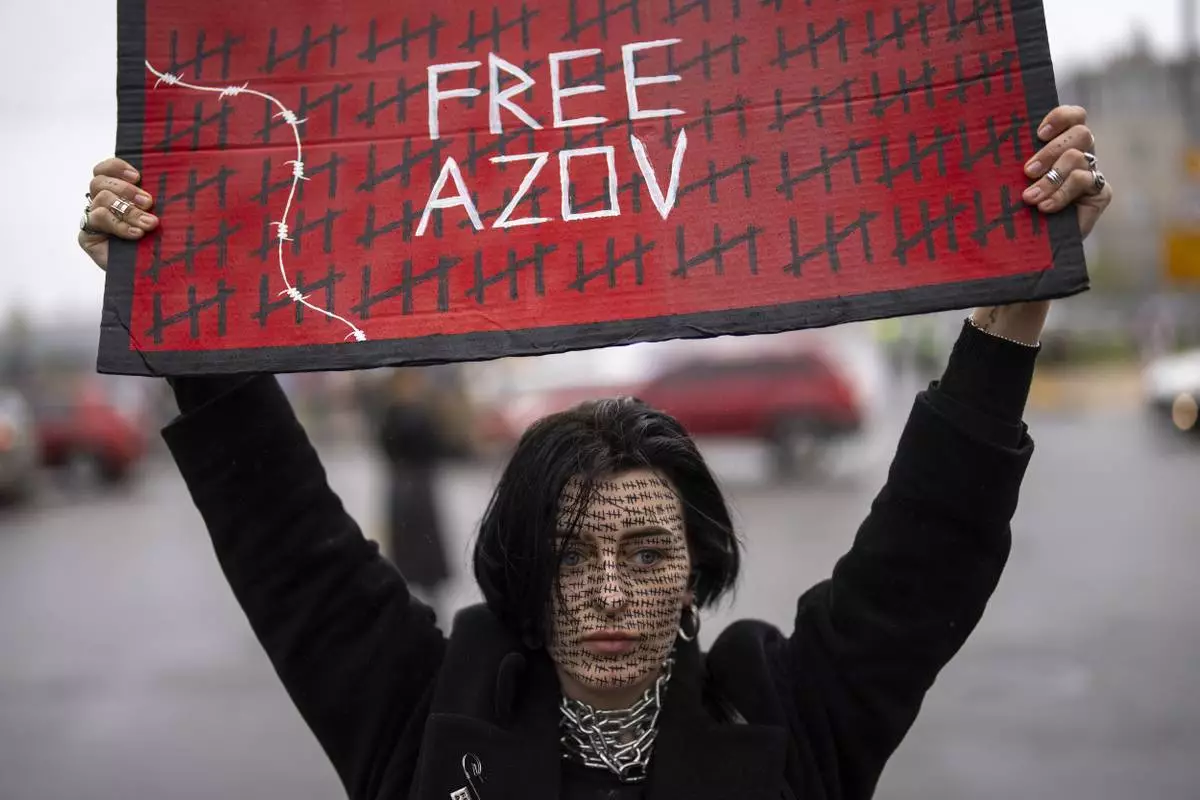
A woman rallies to raise awareness on the fate of Ukrainian prisoners of war in Kyiv, Ukraine, Sunday, April 21, 2024. (AP Photo/Francisco Seco)
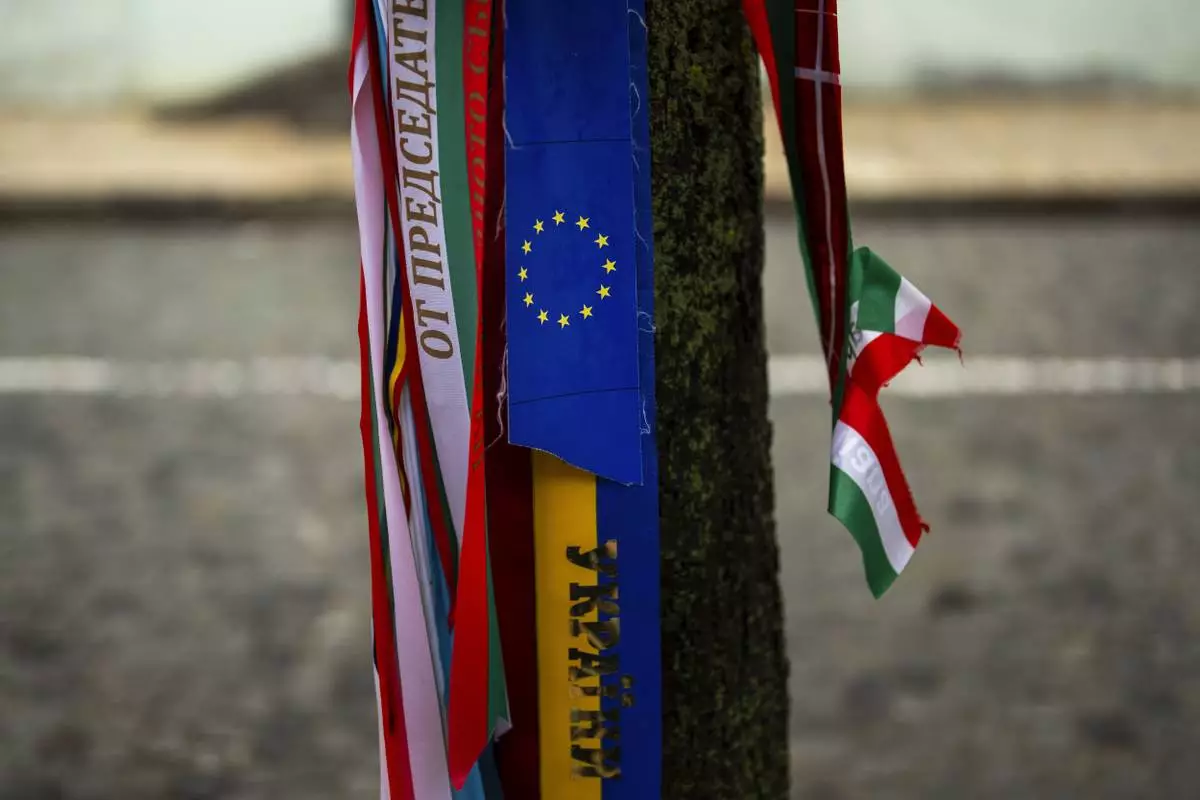
Ribbons with the colors of the European Union and Ukraine are attached to a tree next to memorial wall of Ukrainian soldiers killed during the war in Kyiv, Ukraine, Monday, April 22, 2024. (AP Photo/Francisco Seco)
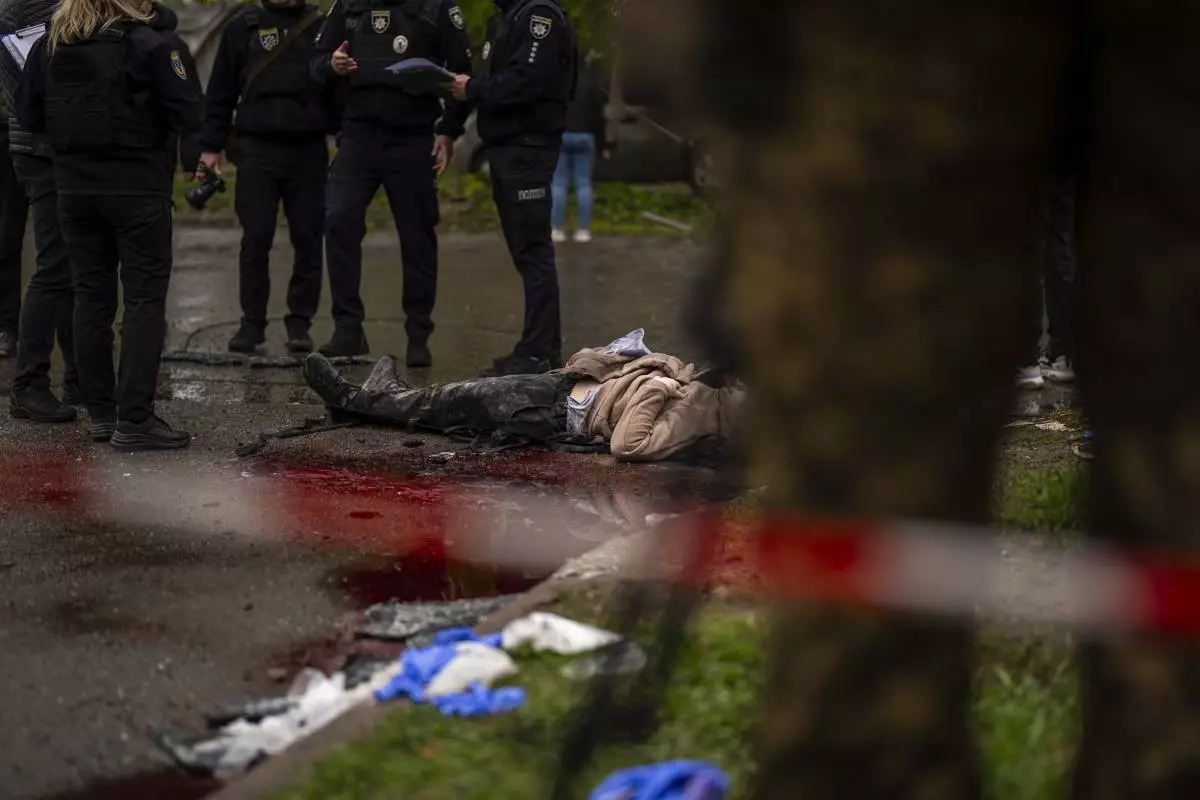
The body of a woman killed by Russian bombardment in Chernihiv, Ukraine, Wednesday, April 17, 2024. (AP Photo/Francisco Seco)

Soldiers carry the coffins of two Ukrainian army sergeants during their funeral in Lviv, Ukraine, Tuesday, April 16, 2024. (AP Photo/Francisco Seco)













